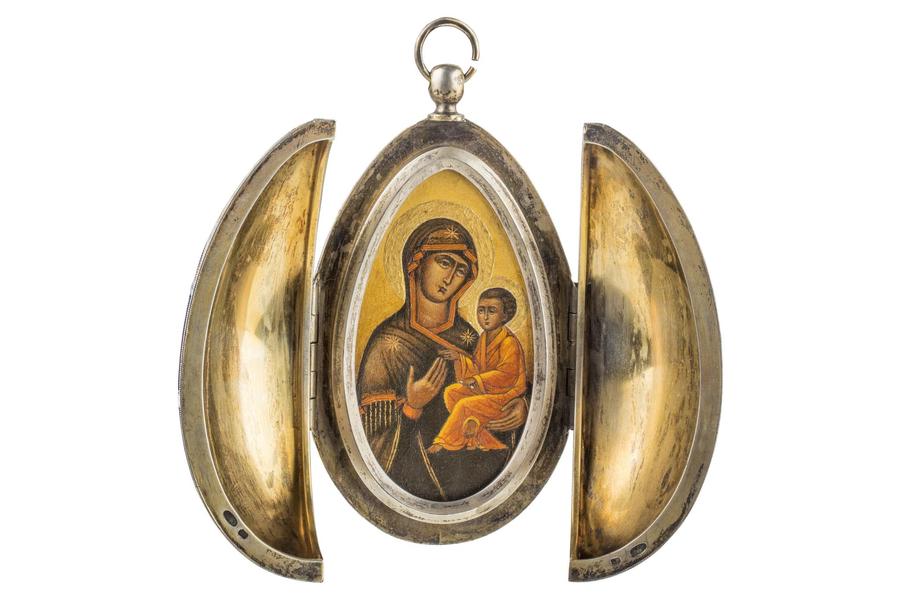Tradition & Opulence: Easter in Imperial Russia at the Museum of Russian Icons
On view at the Museum of Russian Icons through October 25, 2020, Tradition & Opulence: Easter in Imperial Russia, is an exhibition of nearly 200 objects recreating the splendor of Easter celebrations during the last days of the Tsars. From the jeweled creations of Fabergé to humble wood carvings, Russia’s greatest artists, icon painters, jewelers, and artisans have produced imaginative egg designs in every medium for the most important of the Orthodox Christian feasts.

Courtesy Museum of Russian Icons
Tradition & Opulence gathers an unprecedented selection of 19th- and early 20th-century material culture related to Russian Easter celebrations, including icons and works by Fabergé, Ovchinnikov, Grachev, Denisov-Uralsky, the Russian Imperial Porcelain Manufactory, Kuznetsov, and Gardner, as well as ephemera and graphic works on the Easter theme. All of these objects were created and gifted in celebration of Easter, the festival of renewal and resurrection and remain connected by a common chronology, a time when tumultuous change was roiling just beneath the surface of Russian society.
“The waning decades of the Romanov dynasty saw a world of opulence and splendor. All the ceremony, pomp, and magnificence of the era awaits the visitor to this exhibition. But to only look at the glittering surface of these objects is to lose much of the rich and resonant texture of this fascinating and precarious period in Russian history,” says MoRI Executive Director Kent Russell.
“At the time when most of these objects were made, Russia was on the edge of World War I,” Russell continues. “Industrialization and the resulting growth of the prosperous urban, mercantile classes was engendering a period of rapid change and modernization. While the Imperial Court and the aristocracy held tenuous sway, seismic changes were taking place. The Romanov monarchy and the Orthodox Church were the anchors that held Russian society together, but both would be shaken to their core in the first quarter of the twentieth century. Religion and State were inextricably intertwined. This social, religious, and political milieu is the backdrop for the unique objects in this exhibition.”
Easter (Paskha), the “feast of feasts,” celebrates the Resurrection of Christ, one of the foundations of Christian belief, as well as the promise of mankind’s redemption. During the Romanov Era, this annual spring holiday was celebrated with the lavish decoration and exchange of numerous and elaborately decorated eggs.

Courtesy Museum of Russian Icons
The Russian egg tradition dates back to pre-Christian times when people saw eggs as symbols of fertility and renewal. When Russian Orthodoxy was adopted, eggs became a central motif of Christian symbolism; and by the 19th century, the egg’s mystical symbolism and decorative potential was fully exploited by Russian artists and artisans.
Russian Tsars Alexander III and Nicholas II began the tradition of commissioning fantastical and whimsical eggs to be presented as gifts to members of their family. Made of precious metals or stones and encrusted with jewels or decorated with enamel work, these eggs display a craftsmanship, value, and rarity that increases the mystery and romanticism that surrounds them.
The exhibition is curated by Dr. Karen Kettering, Dmitry Gurevich, and Nicholas B. A. Nicholson. An illustrated catalogue will be available.
ABOUT THE MUSEUM
The Museum of Russian Icons inspires the appreciation and study of Russian culture by collecting and exhibiting icons and related objects, igniting the interest of national and international audiences, and offering interactive educational programs. The Museum serves as a leading center for research and scholarship through the Center for Icon Studies and other institutional collaborations. It is the only museum in the US dedicated to Russian icons, and it is the largest collection of icons outside of Russia.
VISITING THE MUSEUM
In order to safely welcome visitors to view the newly reinstalled permanent collection and special exhibitions, the Museum has implemented new hours, timed ticketing, and variety of protocols. A maximum of 20 guests will be allowed in the Museum during each time slot. Reservations are required and can be made by calling Visitor Services at 978.598.5000. As well as limiting hours and number of guests, the Tea Room and Auditorium will be closed since there is not enough room for safe social distancing.
Hours: Friday, Saturday, and Sunday, 11am-5pm. Closed Monday–Thursday.
Four daily time slots: 11:00am-12:30pm; 12:30-2:00pm; 2:00-3:30pm; 3:30-5:00pm.
Admission: Adults $10, seniors (59+) $7, Students $5, Children (3-7) $5, Children under 3 Free.
For more information, please visit museumofrussianicons.org. Follow the Museum of Russian Icons on Facebook, Twitter, and Instagram.









